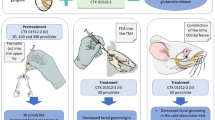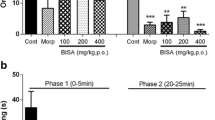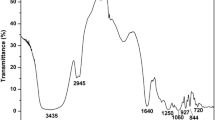Abstract
Terpenes have a wide range of pharmacological properties, including antinociceptive action. The anti-inflammatory and antinociceptive effects of eucalyptol are well established. The purpose of this study was to evaluate the antinociceptive effect of eucalyptol on acute and neuropathic orofacial pain in rodent models. Acute orofacial and corneal nociception was induced with formalin, capsaicin, glutamate and hypertonic saline in mice. In another series, animals were pretreated with capsazepine or ruthenium red to evaluate the involvement of TRPV1 receptors in the effect of eucalyptol. In a separate experiment, perinasal tissue levels of IL-1β, TNF-α and IFN-γ were measured. Rats were pretreated with eucalyptol before induction of temporomandibular joint pain with formalin or mustard oil. In another experiment, rats were submitted to infraorbital nerve transection (IONX) to induce chronic pain, followed by induction of mechanical hypersensitivity using Von Frey hairs. Locomotor performance was evaluated with the open-field test, and molecular docking was conducted on the TRPV1 channel. Pretreatment with eucalyptol significantly reduced formalin-induced nociceptive behaviors in all mouse strains, but response was more homogenous in the Swiss strain. Eucalyptol produced antinociceptive effects in all tests. The effect was sensitive to capsazepine but not to ruthenium red. Moreover, eucalyptol significantly reduced IFN-γ levels. Matching the results of the experiment in vivo, the docking study indicated an interaction between eucalyptol and TRPV1. No locomotor activity changes were observed. Our study shows that eucalyptol may be a clinically relevant aid in the treatment of orofacial pain, possibly by acting as a TRPV1 channel antagonist.



Similar content being viewed by others
References
Anderson EM, Jenkins AC, Caudle RM, Neubert JK (2014) The effects of a co-application of menthol and capsaicin on nociceptive behaviors of the rat on the operant orofacial pain assessment device. PLoS One 9(2):1–9
Brito RG, Santos PL, Prado DS, Santana MT, Araújo AA, Bonjardim LR, Santos MR, de Lucca Júnior W, Oliveira AP, Quintans-Júnior LJ (2013) Citronellol reduces orofacial nociceptive behaviour in mice—evidence of involvement of retrosplenial cortex and periaqueductal grey areas. Basic Clin Pharmacol Toxicol 112(4):215–221
Caldas GF, Limeira MM, Araújo AV, Albuquerque GS, Silva-Neto JD, Silva TG, Costa-Silva JH, Menezes IR, Costa JG, Wanderley AG (2016) Repeated-doses and reproductive toxicity studies of the monoterpene 1,8-cineole (eucalyptol) in Wistar rats. Food Chem Toxicol 97:297–306
Chichorro JG, Lorenzetti BB, Zampronio AR (2004) Involvement of bradykinin, cytokines, sympathetic amines and prostaglandins in formalin-induced orofacial nociception in rats. Br J Pharmacol 141(7):1175–1184
Darwich L, Coma G, Peña R, Bellido R, Blanco E, Este J, Borras F, Clotet B, Ruiz L, Rosell A, Andreo F, Parkhouse M, Bofill M (2009) Secretion of interferon-γ by human macrophages demonstrated at the single-cell level after costimulation with interleukin (IL)-12 plus IL-18. Immunology 126(3):386–393
de Sousa DP, Raphael E, Brocksom U, Brocksom TJ (2004) Antinociceptive profile of 2-phenylselenenyl-1,8-cineole in mice. Biol Pharm Bull 27(6):910–911
Farazifard R, Safarpour F, Sheibani V, Javan M (2005) Eye-wiping test: a sensitive animal model for acute trigeminal pain studies. Brain Res Brain Res Protoc 16(1–3):44–49
Guimarães AG, Silva FV, Xavier MA, Santos MR, Oliveira RC, Oliveira MG, Oliveira AP, de Souza CC, Quintans-Júnior LJ (2012) Orofacial analgesic-like activity of carvacrol in rodents. Z Naturforsch C 67(9–10):481–485
Guimarães AG, Serafini MR, Quintans-Júnior LJ (2014) Terpenes and derivatives as a new perspective for pain treatment: a patent review. Expert Opin Ther Patient 24(3):243–265
Hartwig AC, Mathias SI, Law AS, Gebhart GF (2003) Characterization and opioid modulation of inflammatory temporomandibular joint pain in the rat. J Oral Maxillofac Surg 61:1302–1309
Hegarty DM, Hermes SM, Largent-Milnes TM, Aicher AS (2014) Capsaicin-responsive corneal afferents do not contain TRPV1 at their central terminals in trigeminal nucleus caudalis in rats. J Chem Neuroanat 61–62:1–12
Hu X, Ivashkiv LB (2009) Cross-regulation of signaling pathways by interferon-γ: implications for immune responses and autoimmune diseases. Immunity 31:539–550
Iwata K, Imamura Y, Honda K, Shinoda M (2011) Physiological mechanisms of neuropathic pain: the orofacial region. Int Rev Neurobiol 97:227–250
Juergens UR (2014) Anti-inflammatory properties of the monoterpene 1.8-cineole: current evidence for co-medication in inflammatory airway diseases. Drug Res (Stuttg) 64(12):638–646
Juergens UR, Engelen T, Racké K, Stöber M, Gillissen A, Vetter H (2004) Inhibitory activity of 1,8-cineol (eucalyptol) on cytokine production in cultured human lymphocytes and monocyte. Pulm Pharmacol Ther 17(5):281–287
Kim KY, Lee HS, Seol GH (2015) Eucalyptol suppresses matrix metalloproteinase-9 expression through an extracellular signal-regulated kinase-dependent nuclear factor-kappa B pathway to exert anti-inflammatory effects in an acute lung inflammation model. J Pharm Pharmacol 67(8):1066–1074
Liapi C, Anifandis G, Chinou I, Kourounakis AP, Theodosopoulos S, Galanopoulou P (2007) Antinociceptive properties of 1,8-Cineole and beta-pinene, from the essential oil of Eucalyptus camaldulensis leaves, in rodents. Planta Med 73(12):1247–1254
McNamara CR, Mandel-Brehm J, Bautista DM, Siemens J, Deranian KL, Zhao M, Hayward NJ, Chong JA, Julius D, Moran MM, Fanger CM (2007) TRPA1 mediates formalin-induced pain. Proc Natl Acad Sci USA 104(33):13525–13530
Mogil JS, Lichtensteiger CA, Wilson SG (1998) The effect of genotype on sensitivity to inflammatory nociception: characterization of resistant (A/J) and sensitive (C57BL/6 J) inbred mouse strains. Pain 76(1–2):115–125
Munder M, Mallo M, Eichmann K, Modolell M (1998) Murine macrophages secrete interferon gamma upon combined stimulation with interleukin (IL)-12 and IL-18: a novel pathway of autocrine macrophage activation. J Exp Med 187:2103–2108
Patapoutian A, Tate S, Woolf CJ (2009) Transient receptor channels: targeting pain at the source. Nat Rev Drug Discov 8:55–60
Quintans-Júnior LJ, Melo MS, de Sousa DP, Araújo AA, Onofre AC, Gelain DP, Gonçalves JC, Araújo DA, Almeida JR, Bonjardim LR (2010) Antinociceptive effects of citronellal in formalin-, capsaicin-, and glutamate-induced orofacial nociception in rodents and its action on nerve excitability. J Orofac Pain 24(3):305–312
Ribeiro RA, Souza-Filho MV, Souza MH, Oliveira SH, Costa CH, Cunha FQ, Ferreira HS (1997) Role of resident mast cells and macrophages in the neutrophil migration induced by LTB4, fMLP and C5a des arg. Int Arch Allergy Immunol 112(1):27–35
Ro JY, Chung M-K, Lee JS, Saloman JL, Joseph L (2014) Functional interactions between glutamate receptors and TRPV1 in trigeminal sensory neurons. Mol Pain 10(Suppl. 1):O13
Rocha Caldas GF, Oliveira AR, Araújo AV, Lafayette SS, Albuquerque GS, Silva-Neto JC, Costa-Silva JH, Ferreira F, Costa JG, Wanderley AG (2015) Gastroprotective mechanisms of the Monoterpene 1,8-Cineole (Eucalyptol). PLoS One 5 10(8):e0134558 (1–17)
Romero-Reyes M, Uyanik JM (2014) Orofacial pain management: current perspectives. J Pain Res 7:99–115
Roveroni RC, Parada CA, Veiga MCFA, Tambeli CH (2001) Development of a behavioral model of TMJ pain in rats: the TMJ formalin test. Pain 94:185–191
Santos FA, Rao VS (2000) Antiinflammatory and antinociceptive effects of 1,8-cineole a terpenoid oxide present in many plant essential oils. Phytother Res 14(4):240–244
Santos FA, Silva RM, Tomé AR, Rao VS, Pompeu MM, Teixeira MJ, de Freitas LA, de Souza VL (2001) 1,8-cineole protects against liver failure in an in vivo murine model of endotoxemic shock. J Pharm Pharmacol 53(4):505–511
Sousa-Valente J, Andreou AP, Urban L, Nagy I (2014) Transient receptor potential ion channels in primary sensory neurons as targets for novel analgesics. Br J Pharmacol 171(10):2508–2527
Takaishi M, Fujita F, Uchida K, Yamamoto S, Sawada Shimizu M, Hatai Uotsu C, Shimizu M, Tominaga M (2012) 1,8-cineole, a TRPM8 agonist, is a novel natural antagonist of human TRPA1. Mol Pain 29(8):86
Zhao CH, Sun J, Fang CH, Tang F (2014) 1,8-Cineol attenuates LPS-induced acute pulmonary inflammation in mice. Inflammation 37(2):566–572
Acknowledgements
The authors would like to thank CNPq (310081/2011-4), Funcap (12535647-1) and Capes (053/14) for financial support, and Fundação Edson Queiroz for infrastructure.
Author information
Authors and Affiliations
Corresponding author
Ethics declarations
Conflict of interest
The authors have no conflicts of interest to declare.
Rights and permissions
About this article
Cite this article
Melo Júnior, J.M.A., Damasceno, M.B.M.V., Santos, S.A.A.R. et al. Acute and neuropathic orofacial antinociceptive effect of eucalyptol. Inflammopharmacol 25, 247–254 (2017). https://doi.org/10.1007/s10787-017-0324-5
Received:
Accepted:
Published:
Issue Date:
DOI: https://doi.org/10.1007/s10787-017-0324-5




